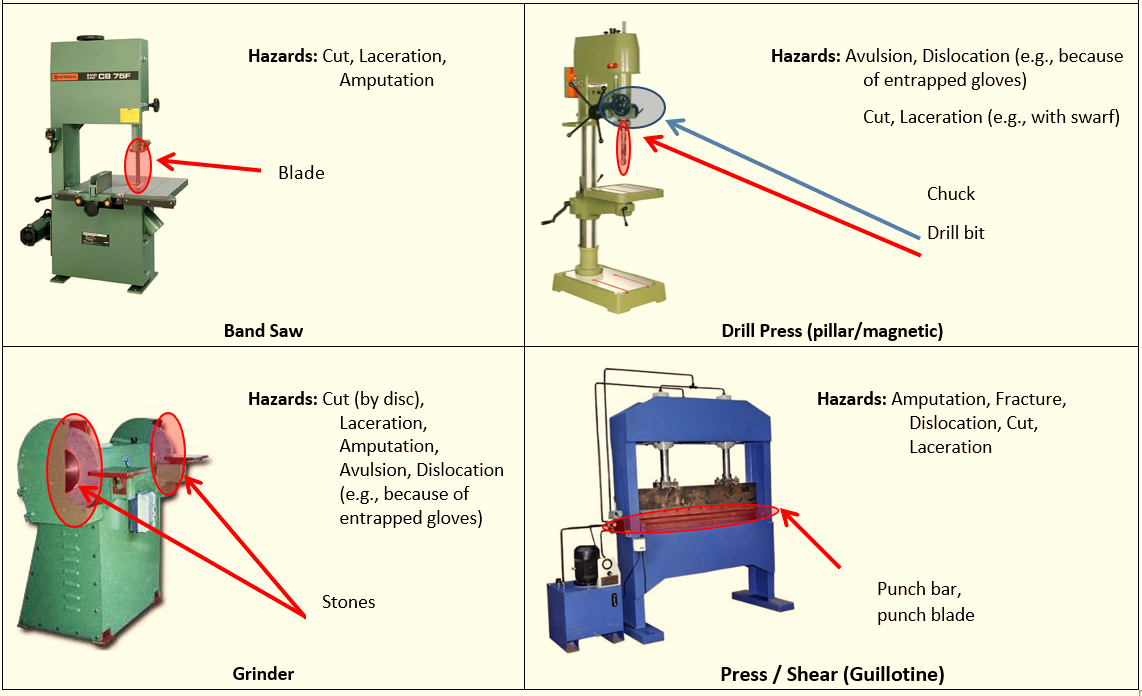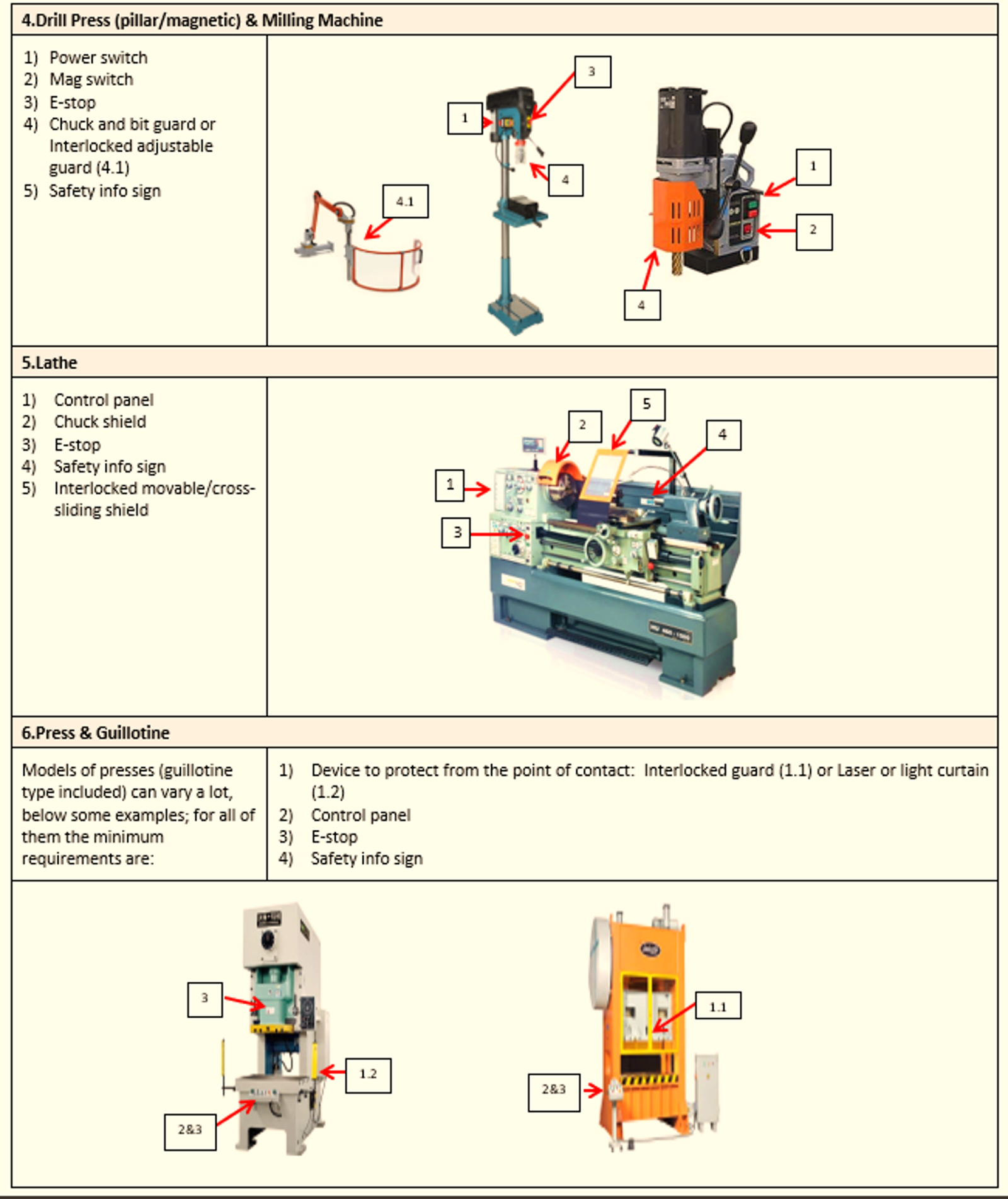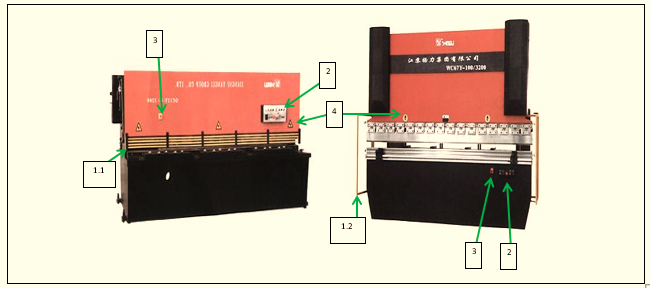Machine Safety and 43-Equipment Inspection Checklists
8 min readThe use of machines, in particular, those with moving parts, expose workers to risks of bodily injuries. The following are some common machine hazards and risks:
- Entanglement – When a worker’s body part or loose items worn by him/her get caught in the moving machine parts.
- Impact – Impact from moving machine parts or pressurized fluid jets that can cause abrasions and bruises.
- Cutting – Contact with moving cutting elements such as blades that can cause severe injuries or amputations.
- Electrical – Contact with faulty electrical components in machines such as live wires that can cause electrocution.
- Heat – Contact with hot machine surfaces can cause skin burns.
- Loud noise – Excessive loud noise generated by machines that can cause noise-induced deafness (NID) after prolonged exposure.
So the Article below is a guideline for the requirement of machine safety and to ensure that all machinery is safe for use and is installed, operated, inspected, and maintained to ensure that it remains so you will be familiar with the following:
- New and Existing Machines
- Work Planning
- Work Equipment
- Machine Operators
- Machine Guarding Inspections and Tests
- Download 43 Free Equipment Inspection Checklist
Also Read: E-Books: Safety With Machinery

New and Existing Machines
All new or modified machines must be provided with the most effective safeguarding means, including the following features, as a minimum:
- When applicable, the front control panel is located/displayed outside the hazardous areas of machines
- Easily accessible and lockable energy shut-down points
- Release devices of energy circuits
- Technical documentation, including as-made drawings
All new machinery must be purchased with appropriate guarding provided by the manufacturer and compliant with Machine Safety Directive 98/37/EC or equivalent.
All guarding must be installed/fitted and maintained in accordance with the manufacturer’s requirements.
Work Planning
A full machine inventory for each operated site must be prepared and maintained and reviewed annually.
A documented machine risk assessment must be performed for all machinery that could potentially expose employees to moving parts or other hazards:
- The presence of all necessary safeguarding means must be assessed including the following as a minimum:
- Fixed or movable physical guards to prevent access to dangerous parts
- Safety distances
- Protective devices with approach function (light curtain, radars, electro-sensitive protective equipment)
- Protective devices (interlocks, two-hand control, emergency stop, enabling switch)
- Risk assessments must be performed prior to any machine being used for the first time or whenever changes in operations occur that could impact the safeguarding
- All phases of operation, set-up, operation, and adjustment, must be considered during the assessment
- Assessments must include all aspects of the machine, not just operator-facing elements.
- See the below Typical Machinery Hazards:
Typical Machinery Hazards
- Unsafe machines and tools can cause injuries in many ways:
- People can be struck and injured by moving parts of machinery or ejected material.
- Parts of the body can also be drawn in or trapped between rollers, belts and pulley drives
- Sharp edges can cause cuts and severing injuries, sharp-pointed parts can cause stabbing or puncturing the skin, and rough surface parts can cause friction or abrasion
- People can be crushed, both between parts moving together or towards a fixed part of the machine, wall, or another object, and two parts moving past one another can cause shearing
- Parts of the machine, materials, and emissions (such as steam or water) can be hot or cold enough to cause burns or scalds, and electricity can cause electrical shock and burns
- Injuries can also occur due to machinery becoming unreliable and developing faults or when machines are used improperly through inexperience or lack of training.
- To properly identify the risks associated with the equipment it is necessary to assess the equipment, checking on hazards brought by the action of each machine or tool:
- Crushing / Shearing / Cutting / Severing / Stabbing
- Entanglement / Drawing in / Trapping / Impact / Abrasion
- High-pressure fluid injection/part ejection
- Other Hazards – such as electrical, thermal, noise, vibration, radiation, dangerous substance handling, ergonomics
Table 1: Typical Types of Machine Hazard

Typical Machine Hazard
- Risk assessments must be communicated to all persons undertaking any work (operation or maintenance) on machines.
- Work instructions for operating or maintaining machinery must be prepared and made available at the workplace; they must include the control measures defined in the risk assessments.
Also Read: Prepare for a Safety Inspection
Work Equipment
Access to dangerous parts of machines must be mitigated by ensuring safeguarding means are in place when the machine is operating. Fixed guarding systems and engineering controls take precedence over administrative controls or PPE use.
Where practicable hazards must be guarded by enclosing guards i.e. guards that protect against a specific hazard, rather than perimeter guarding surrounding the whole machine.
Removing or bridging primary or secondary safeguarding is strictly forbidden at any time during normal operation. If safeguarding is found to have been removed or bridged the machine must be stopped immediately until countermeasures validated by the Site Manager are in place.
Warnings such as ‘Do not operate without guards’, ‘Do not wear loose clothing and other appropriate warnings on specific PPE requirements per local regulations or risk assessment must be fixed to or adjacent to each machine.
Dangerous machine parts that bear the risk of hitting or bumping the operator’s body must be painted in yellow/black zebra stripes or covered with yellow and black striped soft material.
Emergency shut-down systems of the machine (pressure-sensitive body bar, emergency stop buttons, and emergency pull cords) must be easily accessible to the operator and stop the machine cycle in a safe state when activated.
When re-energized, no machine must be able to start by itself.
All fixed machinery must have an accessible disconnect switch that can be either locked or tagged in the off position for the purposes of LOTO.
Note: “Cord & Plug” tools, fixed or not, do not require a disconnect switch
Also Read: Photo of the day: Lockout and Tagout Safety
Machine Operators
Machine Operators must:
- Only operate machinery for which they are competent to do so
- Ensure that safeguarding means are in place when the machine is operating in automatic mode
- Perform the safety checks required of them by this procedure
- Immediately report any machine defects or unsafe conditions to their supervisor
- Not disconnect any interlock, guard, or any other machine safety feature
- Do not wear loose clothing, or jewelry or have loose long hair when operating machinery
- Not wear gloves when operating non-safeguarded rotating machines
- Wear PPE appropriate to their task, as identified in the machine risk assessment
- Maintain a clean work area
When changing tools, adjusting, setting up, or cleaning a machine, machine operators must switch off the automatic mode, lock the system off with a unique key, or, when impossible, use devices such as a remote-control box with a dead man switch.
Machine Guarding Inspections and Tests
Machine operators perform pre-use inspections of machine guarding and safety devices at least daily. It must be ensured that the machine cycle stops in a safe status when emergency devices are activated in automatic mode. If the machine fails to stop during this check it must be stopped immediately until corrective actions, validated by the Site Manager, are in place.
Pre-use inspections must be recorded e.g. using checklists – hard copy / soft copy
Safety devices must be inspected and tested on a regular basis, annually as a minimum, or when changes are made to the machine. The test must confirm that activating the device completely and immediately eliminates hazards to employees.
Also Read: Machinery Guarding: Safety Moment#31
Examples of Machine Guarding
- All machines must be provided with the most effective safeguarding means, including the following features, as a minimum:
- The front control panel is located/displayed outside the hazardous areas of machines
- Easy accessible and lockable energy shut-down points
- Release devices of energy circuits
- Technical documentation, including as-made drawings
- The following represents the minimum requirements for the most common types of machines and tools



Preventative maintenance and inspection programs must include the following as a minimum:
- Legal / Statutory inspections
- Definition of the different types of maintenance activity to be completed on machines with their corresponding frequency (or conditions to be fulfilled for requesting maintenance before a failure occurs). These must include:
- Periodic checks of machine conditions (such as hydraulic system conditions, and potential mechanical fatigue)
- Checks of primary and secondary safeguarding
- Check emergency shut-down systems (with records kept in the maintenance log book or equivalent)
- A failsafe test of machine safeguarding (except for radars) every 6months, as a minimum
- Planning of corrective works when deficiencies are detected
- Records of the maintenance work
- It must be ensured that inspections, hazard hunts or similar include checkpoints to verify that safeguards are in place and operators can never access dangerous points when a machine is operating in automatic mode.
Also Read: Templates: Machine Safeguarding Program
Download the Checklists
These Forms are not all-inclusive. You may wish to add to them or delete portions that do not apply to your workplace. Carefully consider each item as you come to it and then make your decision. Do not spend time with items that have no application to your workplace.
43-Equipment Inspection Checklist
Also Read: Q & A: Does anyone other than equipment operators need to be trained in lockout/Tagout?
More Forms
- Downloadable Kitchen Safety Inspection Checklist for Restaurants
- Mastering LOTO: Protecting Workers with Energy Isolation and Isolation Confirmation Certificates
- Flammable and Combustible Storage Checklist Free Download
- Secure Your Lifts:Guidelines for Safe Lifting Operations Free Planning Tool
- Sample of Accident Prevention Program ( APP) Template for General Industry Free Download
- Free ISO 14001:2015 Environmental Management System Audit Checklist Download
- Guides for Walking and Working Surfaces Safety Program
- Workshop Safety Guideline and free Posters
- Free Ergonomics Checklist for General Industry
- Work Area Safety Checklist
- Machine Safety and 43-Equipment Inspection Checklists
- Scaffold Safety self Audit and checklist
- Hot Work Controls and its Permit to work Form
- Safety Observation Report Template
- Forklift Operator’s Daily Checklist and safety Tips
- Inspecting Fall Protection Equipment Forms
- Templates: HSE Incentives and rewards
- 35 Inspection forms for Rig Check
- Chemical Risk Assessment form
- 22-Safety Inspection Checklists
- Safety Task Assessment Form
- Suspended Scaffold Pre-Operation Inspection Checklist
- Photo of the day: New worker Orientation & Safety Orientation checklist
- Grating-Decking-Floor- handrail-Removal Form
- Electrical Inspection Checklists
- E-Books: Fire Safety Logbook templates
- General Safety Guidelines and Employee Acknowledgment form
- Annual Internal Audit Form
- Mobile Scaffold Inspection checklist
- Simultaneous Operation (SIMOPS) checklist
- Temporary Construction Facilities (TCF) Inspection checklist
- HIRA, HSE Hazards & Effects Management Process (HEMP) & Risk Register Template
- Hazard Identification Plan (HIP) Template
- Ladder Inspection Form
- Free Pre-Startup Safety Review Checklist (PSSR)
- Hazard Identification Checklist
- Workplace Housekeeping Checklist
- ISO 45001:2018 READINESS CHECKLIST
- Lifting Plan Audit Checklist
- Job Safety Analysis (JSA) Forms What’s Right and Wrong?
- Electrical Isolation Permit to Work forms and checklist
- Canteen Inspection Checklist
- Work at Height Checklist
- Health Safety at Work Improvement Action Plan
- Fire Pump Daily Inspection Checklist
- Construction Site Traffic Management Plan (CSTMP) Guidance
- Safety Templates: COVID-19 Safety Plan
- Workplace Safety Inspections Forms
- Lock Removal Form
- Templates: Management of Change NEW Modified Equipment Safety Checklist
- Lifeline & Harness Inspection Guide checklist
- Contractor Pre-qualification Questionnaire Checklist
- Fall safety at construction checklist
- Construction safety Inspection checklist
- Equipment Safe Operating Procedures- SOP 61 checklist
- Permit to Work (PTW ) AUDIT CHECKLIST
- Hygiene and Sanitation Inspection Checklist



